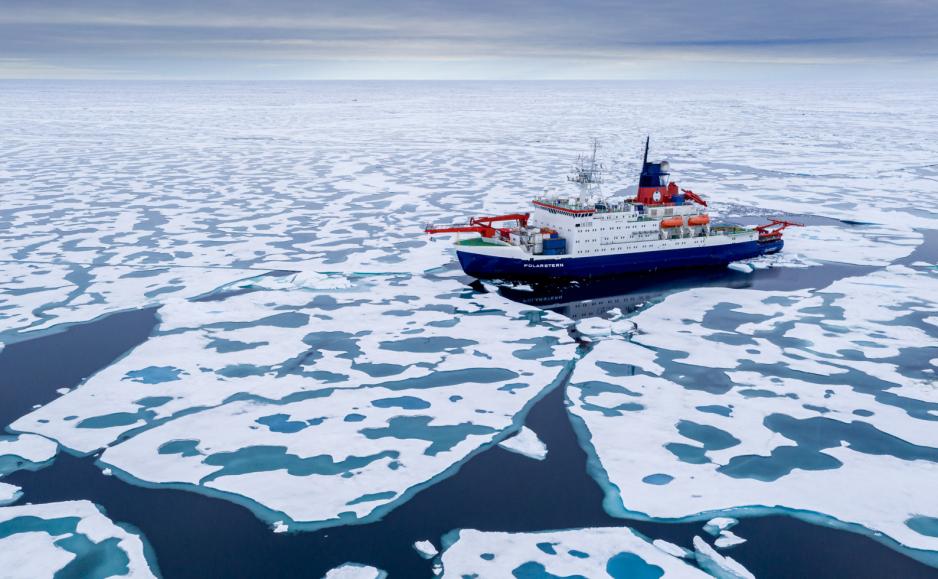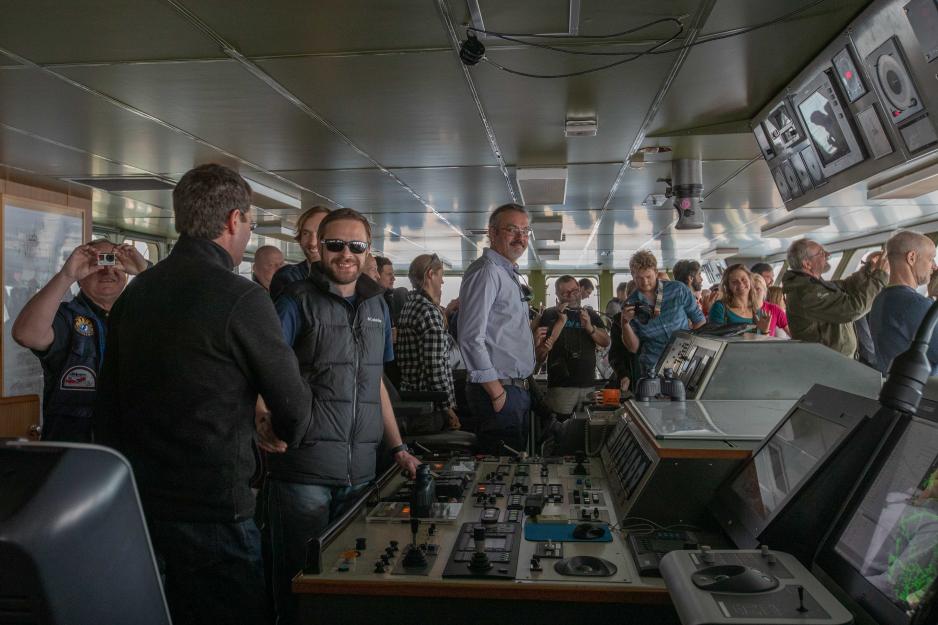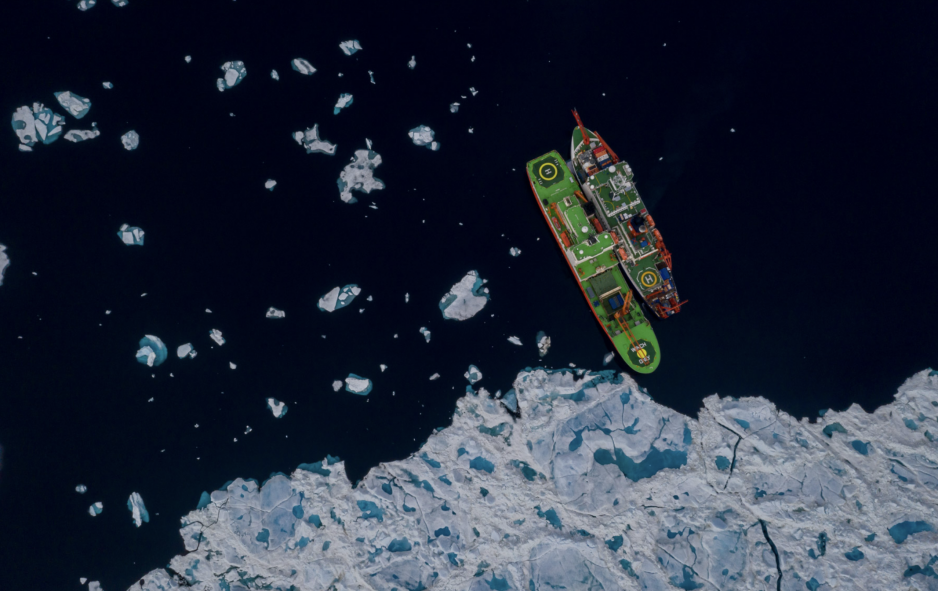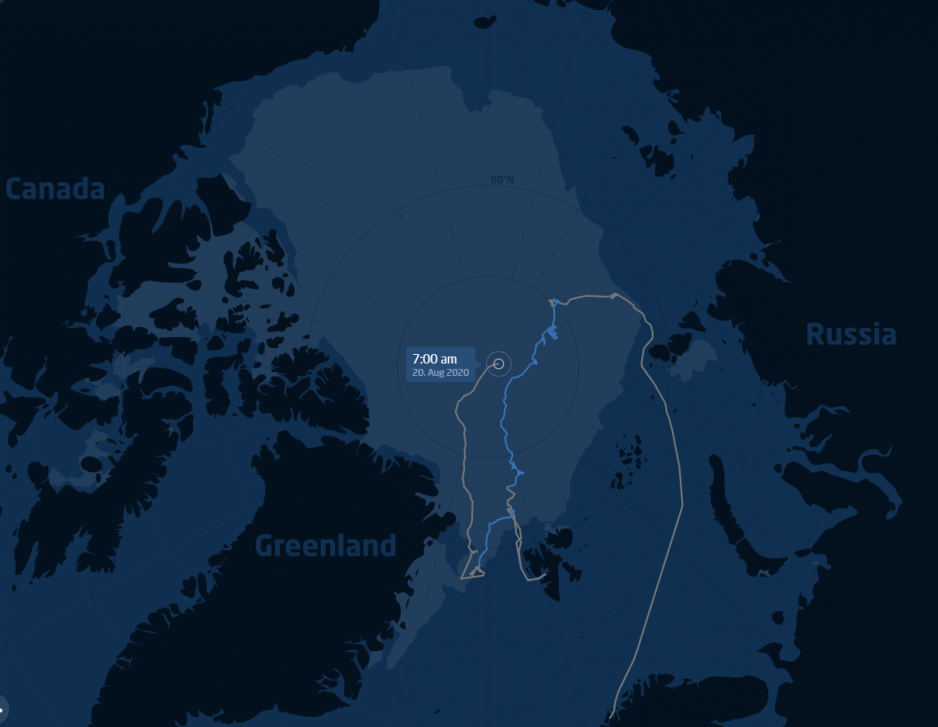International MOSAiC Arctic Expedition Reaches North Pole

Heading for the new MOSAiC ice floe, Polarstern travels towards the North Pole. (Source: Courtesy Steffen Graupner)
The MOSAiC expedition completes another milestone as the Polarstern icebreaker reaches the North Pole. The project now enters its final stage: finding a new ice floe and studying the refreezing of the Arctic Ocean in the Fall.
The year-long MOSAiC international science expedition traveled across the geographic North Pole just after midday on August 19, which the crew celebrated with a small gathering on the Polarstern’s bridge. The Polarstern research icebreaker traveled along the Fram Strait on the North-east side of Greenland in a region that historically used to be home to thick multiyear ice. The vessel, however, encountered only light ice and completed the journey in just six days.
“Up until 87° 30’ North, for the most part we passed through open water, in some cases stretching to the horizon,” recalls MOSAiC Expedition Leader Prof Markus Rex from the Alfred Wegener Institute, Helmholtz Centre for Polar and Marine Research.
The researchers knew from satellite imagery that ice conditions would be light. However, they weren’t sure if this was simply due to wind and currents pushing the ice apart and were worried that the ice could compact again around them. “Then we would have been caught in a mousetrap, and we could have become trapped in the ice,” Rex explained.
Soft and easy
Those concerns, however, proved unwarranted as once the ship arrived in the region the scientists found that most of the ice had really melted away and wasn’t simply broken up by wind. The Polarstern’s captain, Thomas Wunderlich, confirmed the surprisingly easy ice conditions.
“I’m very surprised to see how soft and easy to traverse the ice up to 88° North is this year, having thawed to the point of being thin and porous. Normally it’s wise to avoid the region north of Greenland, because it’s home to the thicker and older ice, and virtually impassable. But now we’re finding extended stretches of open water, reaching nearly to the Pole.”

MOSAiC Team members celebrating on the bridge of the Polarstern after reaching the North Pole. (Source: Courtesy Lianna Nixon)
Leaving original ice floe and resupply
At the beginning of the month the Polarstern left the ice floe it had been accompanying for the last ten months. The ice floe had started to break into several fragments at the end of July prompting expedition leaders to dismantle the research camp and evacuate staff and equipment back to the Polarstern.
The Polarstern had been enclosed in the ice floe and drifting across the center of the Arctic Ocean since early October 2019 allowing for the conducting of a wide range of scientific experiments. Research showed that the ice floe was originally created near the New Siberian Islands in December 2018.
I’m very surprised to see how soft and easy to traverse the ice up to 88° North is this year, having thawed to the point of being thin and porous.
“We’ve successfully monitored the lifecycle of the MOSAiC floe from early October last year to its end. It carried us through the Arctic Ocean for a total of 1700 kilometres, from the Laptev Sea, past the North Pole and all the way to Fram Strait,“ says Rex. Following the ice floe’s life cycle until it disintegrated into small fragments and ultimately melts away was the key mission of the expedition.
The departure from the ice floe was met with mixed feelings as it had been home to the team aboard the Polarstern icebreaker for almost a year. “Last autumn we looked for, found, scouted, colonised and investigated our floe from every possible perspective. Ever since, it has been a steadfast, stable basis for our research camp. Over the many months the ice floe has become our home, and we’ll always remember it fondly. But now it becomes water again. The time has come to bid it farewell and head north for the final phase of the expedition,” explains Rex.

The Polarstern alongside Akademik Tryoshnikov during the resupply last week. (Source: Courtesy Steffen Graupner)
After facing a host of logistical challenges due to the Covid-19 pandemic – which necessitated the Polarstern to temporarily leave the ice floe to rendezvous with supply vessels off the coast of Svalbard in June – the expedition met up with Russian research icebreaker Akademik Tryoshnikov near the ice edge last week for another exchange of crew and supplies. The Akademik Tryoshnikov departed from Bremerhaven, Germany and as in previous crew exchanges, staff and scientists underwent a quarantine to ensure no transmission of the Corona virus to the Polarstern.
Finding a new ice floe for final months
The final goal of MOSAiC is now to study the start of the refreezing of sea ice at the end of the summer season. For this purpose the ship began heading further North, where ice begins to form the earliest, about two weeks ago
The Polarstern now plans to travel along the Transpolar Drift, an ocean current, a bit further but then the researchers will begin looking for a new ice floe to attach themselves to for the coming months to observe and study the re-freezing of the ocean. Ideally the expedition hopes to find a new temporary home that is similar to the original ice floe ensuring the compatibility of scientific findings.


